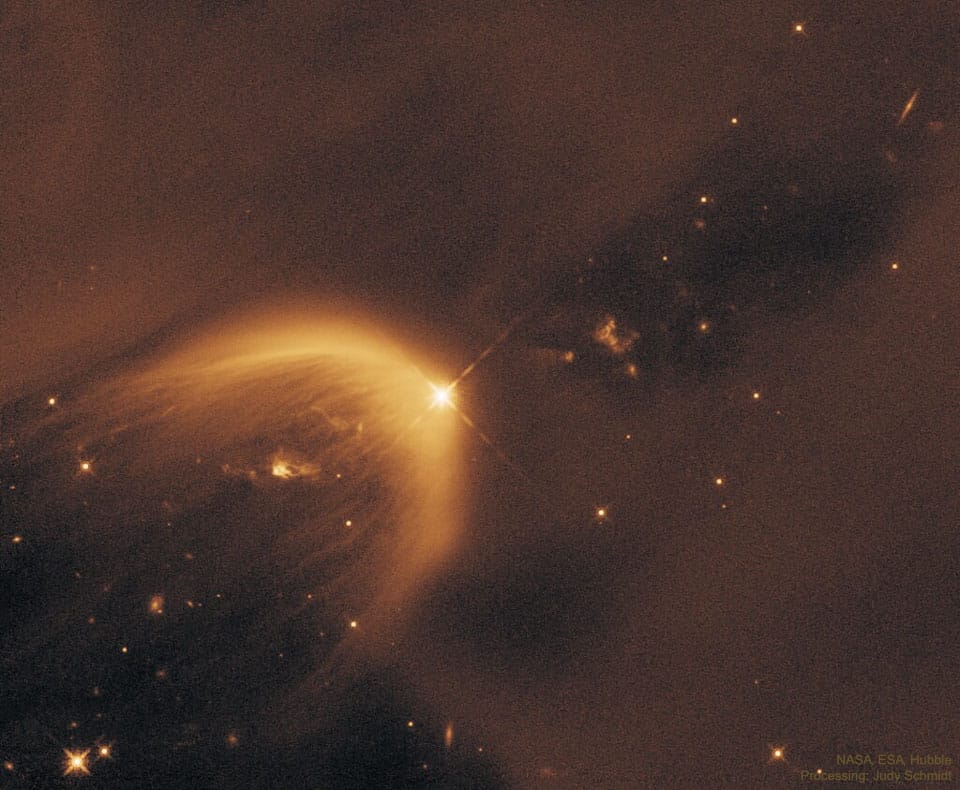Blog
https://www.youtube.com/watch?v=-fTYhctc_ew
more...Arp 299, the enigmatic colliding galaxies expelling the radiation. The two galaxies of Arp 299 have been locked in a gravitational combat for millions of years, while their central black holes will soon do battle themselves. Featured, the high-resolution visible-light image was taken by Hubble, while the superposed diffuse glow of X-ray light was imaged by NuSTAR and shown in false-color red, green, and blue. NuSTAR observations show that only one of the central black holes is seen fighting its way through a region of gas and dust — and so absorbing matter and emitting X-rays. The energetic radiation, coming only from the galaxy center on the right, is surely created nearby — but outside — the central black hole‘s event horizon. In a billion years or so, only one composite galaxy will remain, and only one central supermassive black hole. Soon thereafter, though, another galaxy may enter the fray.

William Kreutzmann Jr. (/ˈkrɔɪtsmɑːn/ KROYTS-mahn; born May 7, 1946) is an American drummer. He played with the Grateful Dead for its entire thirty-year career, usually alongside fellow drummer Mickey Hart, and has continued to perform with former members of the Grateful Dead in various lineups, and with his own bands BK3, 7 Walkers and Billy & the Kids.
Kreutzmann was born in Palo Alto, California, the son of Janice Beryl (née Shaughnessy) and William Kreutzmann Sr. His father was of German descent. His maternal grandfather was football coach and innovator Clark Shaughnessy.
Kreutzmann started playing drums at the age of 13. At first he practiced on a Slingerland drum kit lent to him. As a teenager, practicing drums alone in a large building at his high school, Aldous Huxley and another man walked in. Huxley told Bill he’d never heard anything like it, and encouraged him in his drumming – despite the fact Bill had been told by his sixth grade music teacher that he could not keep a beat. Kreutzmann continued to practice a great deal. His earliest enthusiasm was for the music of Ray Charles and other R&B musicians. He has explained that later he learned some advanced technique or tricks from Mickey Hart.
Kreutzmann listened to jazz groups in clubs when he found an opportunity for an under-age guy to get in. After joining the Warlocks (later called the Grateful Dead), bassist Phil Lesh introduced him the work of one of the top jazz drummers of the time, Elvin Jones. Kreutzmann became an enthusiast, also, for the funk music of The Meters.
more...
Joe Ford (born May 7, 1947, Buffalo, New York) is an American jazz saxophonist.
Ford studied saxophone under Makanda Ken McIntyre, Jackie McLean, and Frank Foster, and percussion under Joe Chambers. He took his Bachelor’s in music education in 1968 from Central State University, then taught in Buffalo public schools from 1968 to 1972. While working at the Buffalo Public Library in 1974-75, Ford played in the Birthright ensemble, then played with McCoy Tyner in 1976. Since the early 1980s he has worked extensively as a sideman, playing with Sam Jones, Lester Bowie, Jimmy Owens, Idris Muhammad, Abdullah Ibrahim, Chico O’Farrill, Saheb Sarbib (1984), Avery Sharpe (1988), Jerry Gonzalez (from 1988), Larry Willis (1989), Michael Logan (1990), Malachi Thompson (1991), John Blake (1992), Ronnie Burrage (1993), Hannibal Marvin Peterson (1993), Freddie Cole (1993), Steve Berrios (1995), and Nova Bossa Nova (1997).
In the late 1990s he led two ensembles, the Black Art Sax Quartet and a big band called The Thing. He has released one album as a leader, 1993’s Today’s Night on Blue Moon Records. It features Charles Fambrough, Kenny Kirkland and Jeff “Tain” Watts.
more...Admirl Amos Easton (May 7, 1905 – June 8, 1968), better known by the stage name Bumble Bee Slim, was an American Piedmont bluessinger and guitarist.
Easton was born in Brunswick, Georgia. Several original sources confirm that he spelled his first name “Admirl”. Around 1920 he joined the Ringling Brothers circus. He then returned to Georgia and was briefly married before heading north on a freight train to Indianapolis, where he settled in 1928. There he met and was influenced by the pianist Leroy Carr and the guitarist Scrapper Blackwell.
By 1931 he had moved to Chicago, where he made his first recordings, as Bumble Bee Slim, for Paramount Records. The following year his song “B&O Blues” was a hit for Vocalion Records, inspiring a number of other railroad blues and eventually becoming a popular folk song. In the next five years he recorded over 150 songs for Decca Records, Bluebird Records and Vocalion,often accompanied by other musicians, including Big Bill Broonzy, Peetie Wheatstraw, Tampa Red, Memphis Minnie, and Washboard Sam.
In 1937, he returned to Georgia. He relocated to Los Angeles, California, in the early 1940s, apparently hoping to break into motion pictures as a songwriter and comedian. During the 1950s he recorded several albums, but they had little impact. His last album was released in 1962 by Pacific Jazz Records.
He continued to perform in clubs around Los Angeles until his death in 1968.
https://www.youtube.com/watch?v=9i1xrwYBlFw
more...Pyotr Ilyich Tchaikovsky (English: /tʃaɪˈkɒfski/ chy-KOF-skee;[1] Russian: Пётр Ильи́ч Чайко́вский, tr. Pëtr Ilʹič Čajkovskij, IPA: [pʲɵtr ɪlʲˈjitɕ tɕɪjˈkofskʲɪj]; 7 May [O.S. 25 April] 1840 – 6 November [O.S. 25 October] 1893) was a Russian composer of the Romantic period. He was the first Russian composer whose music made a lasting impression internationally, bolstered by his appearances as a guest conductor in Europe and the United States. He was honored in 1884 by Tsar Alexander III, and awarded a lifetime pension.
Although musically precocious, Tchaikovsky was educated for a career as a civil servant. There was scant opportunity for a musical career in Russia at that time and no system of public music education. When an opportunity for such an education arose, he entered the nascent Saint Petersburg Conservatory, from which he graduated in 1865. The formal Western-oriented teaching he received there set him apart from composers of the contemporary nationalistmovement embodied by the Russian composers of The Five, with whom his professional relationship was mixed. Tchaikovsky’s training set him on a path to reconcile what he had learned with the native musical practices to which he had been exposed from childhood. From this reconciliation he forged a personal but unmistakably Russian style—a task that did not prove easy. The principles that governed melody, harmony and other fundamentals of Russian music ran completely counter to those that governed Western European music; this seemed to defeat the potential for using Russian music in large-scale Western composition or for forming a composite style, and it caused personal antipathies that dented Tchaikovsky’s self-confidence. Russian culture exhibited a split personality, with its native and adopted elements having drifted apart increasingly since the time of Peter the Great. This resulted in uncertainty among the intelligentsia about the country’s national identity—an ambiguity mirrored in Tchaikovsky’s career.
Despite his many popular successes, Tchaikovsky’s life was punctuated by personal crises and depression. Contributory factors included his early separation from his mother for boarding school followed by his mother’s early death, the death of his close friend and colleague Nikolai Rubinstein, and the collapse of the one enduring relationship of his adult life, which was his 13-year association with the wealthy widow Nadezhda von Meck who was his patron even though they never actually met each other. His homosexuality, which he kept private, has traditionally also been considered a major factor, though some musicologists now downplay its importance. Tchaikovsky’s sudden death at the age of 53 is generally ascribed to cholera; there is an ongoing debate as to whether cholera was indeed the cause of death, and whether his death was accidental or self-inflicted.
While his music has remained popular among audiences, critical opinions were initially mixed. Some Russians did not feel it was sufficiently representative of native musical values and expressed suspicion that Europeans accepted the music for its Western elements. In an apparent reinforcement of the latter claim, some Europeans lauded Tchaikovsky for offering music more substantive than base exoticism and said he transcended stereotypes of Russian classical music. Others dismissed Tchaikovsky’s music as “lacking in elevated thought” and derided its formal workings as deficient because they did not stringently follow Western principles.
more...What is the cause of this unusual parabolic structure? This illuminated cavity, known as LDN 1471, was created by a newly forming star, seen as the bright source at the peak of the parabola. This protostar is experiencing a stellar outflow which is then interacting with the surrounding material in the Perseus Molecular Cloud, causing it to brighten. We see only one side of the cavity — the other side is hidden by dark dust. The parabolic shape is caused by the widening of the stellar-wind blown cavity over time. Two additional structures can also be seen either side of the protostar, these are known as Herbig-Haro objects, again caused by the interaction of the outflow with the surrounding material. What causes the striations on the cavity walls, though, remains unknown. The featured image was taken by NASA and ESA’s Hubble Space Telescope after an original detection by the Spitzer Space Telescope.

Robert Clark Seger (/ˈsiːɡər/, born May 6, 1945) is an American singer, songwriter and musician. As a locally successful Detroit-area artist, he performed and recorded as Bob Seger and the Last Heard and Bob Seger System throughout the 1960s, breaking through with his first album, Ramblin’ Gamblin’ Man (which contained his first national hit of the same name) in 1968. By the early 1970s, he had dropped the ‘System’ from his recordings and continued to strive for broader success with various other bands. In 1973, he put together the Silver Bullet Band, with a group of Detroit-area musicians, with whom he became most successful on the national level with the album Live Bullet (1976), recorded live with the Silver Bullet Band in 1975 at Cobo Hall in Detroit, Michigan. In 1976, he achieved a national breakout with the studio album Night Moves. On his studio albums, he also worked extensively with the Alabama-based Muscle Shoals Rhythm Section, which appeared on several of Seger’s best-selling singles and albums.
A roots rocker with a classic raspy, powerful voice, Seger wrote and recorded songs that deal with love, women, and blue-collar themes and is an example of a heartland rock artist. Seger has recorded many hits, including “Night Moves“, “Turn the Page“, “Still the Same“, “We’ve Got Tonite“, “Against the Wind“, “You’ll Accomp’ny Me“, “Hollywood Nights“, “Shame on the Moon“, “Like a Rock“, and “Shakedown“, the last of which was written for the 1987 film Beverly Hills Cop II and topped the Billboard Hot 100 chart. Seger also co-wrote the Eagles‘ number-one hit “Heartache Tonight“, and his recording of “Old Time Rock and Roll” was named one of the Songs of the Century in 2001.
With a career spanning six decades, Seger has sold more than 75 million records worldwide, making him one of the world’s best-selling artists of all time. Seger was inducted into the Rock and Roll Hall of Fame in 2004 and the Songwriters Hall of Fame in 2012.[2][3][4][5] Seger was named Billboard‘s 2015 Legend of Live honoree at the 12th annual Billboard Touring Conference & Awards, held November 18–19 at the Roosevelt Hotel in New York. He announced his farewell tour in September 2018.
more...David Friesen (born May 6, 1942 in Tacoma, Washington) is an American jazz bassist. He plays double bass and electric upright bass. Friesen was an autodidact on bass, having picked it up while serving in the U.S. Army in Germany. He played with John Handy and Marian McPartland and following this, with Joe Henderson; in 1975, he toured in Europe with Billy Harper. His first album as a session leader appeared that year. In 1976, he began collaborating with guitarist John Stowell; the pair would work together often. He appeared with Ted Curson at the Monterey Jazz Festival in 1977. Following this, he worked with Ricky Ford, Duke Jordan, Mal Waldron, and Paul Horn. His 1989 album Other Times, Other Places reached No. 11 on the U.S. Billboard Top Jazz Albums chart. He has also played with Chick Corea, Michael Brecker, Stan Getz, Dexter Gordon, Kenny Garrett, Dizzy Gillespie, and Mal Waldron.
His sister is the actress Dyan Cannon
more...Eddie C. Campbell (May 6, 1939 – November 20, 2018) was an American blues guitarist and singer in the Chicago blues scene. Campbell was born in Duncan, Mississippi. He moved to Chicago at the age of ten, and by age 12 was learning from the blues musicians Muddy Waters, Magic Sam, and Otis Rush.
In his early years as a professional musician, he played as a sideman with Howlin’ Wolf, Little Walter, Little Johnny Taylor, and Jimmy Reed. In 1976, Willie Dixon hired him to play in the Chicago Blues All-Stars. Campbell’s debut album, King of the Jungle, featuring Carey Bell on harmonica and Lafayette Leake on piano, was released the next year.
In 1984, Campbell left Chicago for Europe, living first in the Netherlands and later in Duisburg, Germany, where he remained for ten years before returning to Chicago.
more...In this image, the heart of the spiral galaxy M77 observed by ALMA (Atacama Large Millimeter/submillimeter Array) is superimposed on a visible light image taken by the Hubble Space Telescope. The distribution of cyanoacetylene (HC3N) is shown in yellow; the distribution of carbon monosulfide (CS) in red; and the distribution of carbon monoxide (CO) in blue. Through ALMA observations, the existence of organic molecules concentrated around the supermassive black hole in the center of M77 was revealed for the first time.

Marija Šestić (Serbian Cyrillic: Марија Шестић; born 5 May 1987) is a Bosnian singer and musician. She is most known for representing Bosnia and Herzegovina in the Eurovision Song Contest 2007 in Helsinki, Finland. Performing the song “Rijeka bez imena” (“Nameless river”), Šestić collected a total of 106 points, placing eleventh out of twenty-four entries.
A pianist by trade, Šestić has achieved top results in domestic festivals and also had the chance to be the first artist from the former Yugoslavia to appear on MTV Europe. Marija attempted to reach Eurovision in 2005 and with the song “In This World”, she ended up in a respectable fourth place at the national final.
more...Stanley Cowell (born May 5, 1941) is an American jazz pianist and co-founder of the Strata-East Records label. Cowell was born in Toledo, Ohio. He began playing the piano at around the age of four, “and first became interested in jazz after gaining exposure to the music of pianist Art Tatum, a family friend”. “After high school, he attended both the Oberlin College Conservatory and the University of Michigan, during which time he also gained valuable experience playing with Rahsaan Roland Kirk“. He moved to New York in the mid-1960s.
Cowell played with Marion Brown, Max Roach, Bobby Hutcherson, Clifford Jordan, Harold Land, Sonny Rollins and Stan Getz. Cowell played with trumpeter Charles Moore and others in the Detroit Artist’s Workshop Jazz Ensemble in 1965–66. During the late 1980s Cowell was part of a regular quartet led by J.J. Johnson. Cowell taught in the Music Department of the Mason Gross School of the Arts at Rutgers, the State University of New Jersey.
https://www.youtube.com/watch?v=BJN-P-GFqOM
more...J. B. Lenoir /ləˈnɔːr/ (March 5, 1929 – April 29, 1967) was an American blues guitarist and singer-songwriter, active in the Chicago blues scene in the 1950s and 1960s.
His surname, which is French, is sometimes pronounced as the French “L’n WAHR”, but he pronounced it “La NOR”. His given name simply was J. B.; the letters are not initials.
He was born in Monticello, Mississippi. Lenoir’s guitar-playing father introduced him to the music of Blind Lemon Jefferson, which became a major influence. During the early 1940s, Lenoir worked with the blues artists Sonny Boy Williamson II and Elmore James in New Orleans. He was later influenced by Arthur Crudup and Lightnin’ Hopkins.
In 1949, he moved to Chicago, where Big Bill Broonzy helped introduce him to the blues community. He began to perform at local nightclubs, with musicians such as Memphis Minnie, Big Maceo Merriweather, and Muddy Waters, and became an important part of the city’s blues scene. He began recording in 1951 for J.O.B. Records and Chess Records. His recording of “Korea Blues” was licensed to and released by Chess, as having been performed by J. B. and his Bayou Boys. His band included the pianist Sunnyland Slim, the guitarist Leroy Foster, and the drummer Alfred Wallace.
more...More Posts
- Bobby Sharp
- World Music Karjalan Jouhikko
- Daily Roots Scientist
- Cosmos NGC 2090
- Val Fuentes
- Etta James
- Nat Adderley
- Paul Desmond
- World Music Maouzoun
- Daily Roots Scientist
- Fall of Rome 2024
- Missing and Murdered Indigenous Women (MMIW)
- Thanksgiving Week 2024
- Cosmos NGC 7293
- Wild Bill Davis
- Teddy Wilson
- Scott Joplin
- World Music Funmilayo Afrobeat Orquestra
- Daily Roots Viceroys
- Coerced Conversion